Pompano Dolphin
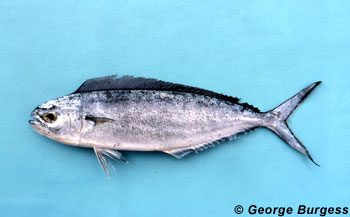
Coryphaena equiselis
The pompano dolphin (not related to the marine mammal) is a silvery, colorful fish with bright blue-green on top, yellow sides, and a white/gold underside. It has a long body, reaching up to 50 inches, with a distinctly forked caudal fin (tail) and a dorsal fin that runs the length of its body. Males grow bigger than females and develop a protruding forehead. They are smaller than their cousins, the common dolphinfish, but they’re still quite popular as a game fish.
Order – Perciformes
Family – Coryphaenidae
Genus – Coryphaena
Species – equiselis
Common Names
The common name for this fish is a source of much confusion. The fish known as the “dolphin” is not related to the marine mammal of the same common name (family Delphinidae). Two species of dolphin fish exist, the common dolphinfish (C. hippurus) and the pompano dolphin (C. equiselis). Both these species are commonly marketed by their Pacific name, mahi-mahi. Other common English language names include blue dolphin, dolphin, little dolphin, pompano dolfinfish, pompano dolphinfish, and small dolphin. Other language names are anfalus (Arabic), colombeta (Portuguese), delfim (Portuguese), doirado (Portuguese), dolpin (Tagalog), dorade (French), dorado (Spanish), douorado (Portuguese), ebisu-shiira (Japanese), falusi (Swahili), koryfena mala (Polish), lagos (Greek), Lampuka (Maltese), llampuga borda (Catalan), mahimahi (Hawaiian), pomapano-dorade (Afrikaans), sucbaan (Somali), and ti klik (French Creole).
Importance to Humans
Pompano dolphins, being smaller than common dolphin, are of little importance to commercial fisheries. This dolphin is a very popular game fish throughout its range. They are usually hooked by anglers who are trolling for other species and encounter a school of dolphin. Anglers who seek dolphin specifically scan the water for Sargassum lines. Dolphin fishing is especially popular off North Carolina, Florida, the Gulf of Mexico, the Bahamas, the Caribbean Sea, the Mediterranean Sea, Spain, Hawaii, and Japan. June through September are the primary months of the fishery, although most sport catches around Florida occur between March and August.
Because they exhibit fast growth and a short lifespan, dolphin populations have not suffered as much as other pelagic species from recent increases in fishing pressure.
Conservation
> Check the status of the pompano dolphin at the IUCN website.
The IUCN is a global union of states, governmental agencies, and non-governmental organizations in a partnership that assesses the conservation status of species.
Geographical Distribution
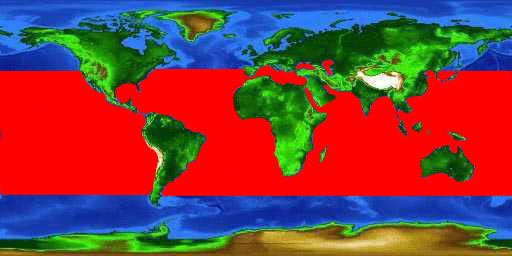
Worldwide, there have been fewer reports of the pompano dolphin compared to the common dolphin. This is, in part, due to the fact that the pompano dolphin is the more oceanic of the two species. Misidentification of specimens is probably a key factor in this disparity as well. Pompano dolphins are often mistaken for female or immature common dolphins. In the western Atlantic Ocean, the pompano dolphin is known offshore North Carolina, Florida, Bermuda, the Gulf of Mexico, and Caribbean Sea. Throughout the world, the pompano dolphin is found in locations between 45°N and 45°S. In the eastern Atlantic Ocean, this includes the Azores, the Canary Islands, Madeira, and Senegal. It has also been identified throughout the Mediterranean Sea, Indian Ocean, and Pacific Ocean.
Habitat
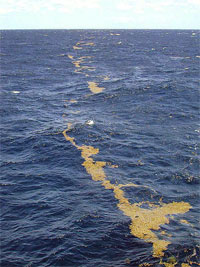
The pompano dolphin is oceanic, distributed worldwide in tropical and subtropical waters. Unlike the common dolphin, it is rarely caught in coastal waters. It is also rarely found in water less than 24°C at the surface.
Dolphins school at all sizes. They are commonly observed schooling under drift lines of seaweed, or under floating debris and boats. Dolphins may separate into schools based upon size and/or sex. Common and pompano dolphins have been observed in the same school. Little is known of migratory patterns. It is not uncommon for dolphin schools to follow drifting debris or vessels for many days, indicating that these chance encounters may dictate their movements.
There are reports of young dolphin following a Sargassum line for 230 miles (370 km), of dolphin schooling under a raft as it was towed 30 miles (48 km), and of pompano dolphin following a sailboat for 19 days. The crew of the Kon-Tiki ate dolphin throughout the voyage from Peru to the Indo-Pacific that took approximately 150 days. It is recognized that dolphins generally migrate northward during the spring and summer. This may represent a response to movements of food items, the expansion of their range due to warmer water temperatures, or prespawning activity.
Biology
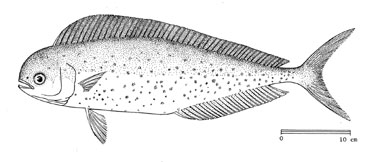
Distinctive Features
The two species of dolphin fish are easily distinguishable. Both exhibit the same elongate, fusiform body shape. The single dorsal fin extends the length of the body. The anal fin begins approximately in the middle of the body and ends at the same point as the dorsal fin. The pelvic fins are inserted under the pectoral fins and can be compressed into a shallow groove on the body. The caudal fin is strongly forked. The head is blunt and the mouth contains many small teeth. The tongue tooth patch is large and square. Cycloid scales cover the body. Mature males develop a prominent bony ridge at the front of the head. The pompano dolphin can be separated from the common dolphinfish by its body depth, which is greater than 25% of its standard length. This dolphin generally has fewer dorsal fin rays than the common dolphin (52-59) and more vertebrae (33), the difference being in the number of caudal vertebrae. In juveniles, the entire margins of the caudal fins are white and the pelvic fins unpigmented.
Coloration
Pompano dolphins are among the most colorful pelagic gamefish. The dorsal surface is bright blue and green, the sides are yellow and gold with blue-green overtones, and the ventral surface is white or yellow. Many small black dots are present over the head and body. Juveniles have distinct bars on the sides.
Dentition
Dentition helps to distinguish the pompano dolphin (C. equiselis) from the common dolphin (C. hippurus). The pompano dolphin has a squarish tooth patch on the tongue in contrast to the common dolphin that has a oval tooth patch.
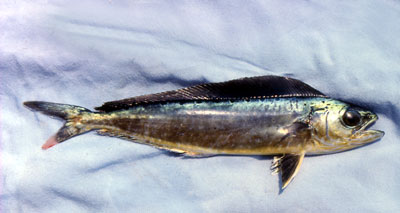
Size, Age, and Growth
Males and females are approximately equal in weight up to a length of 37 inches (95 cm), at which point the males are heavier than the females. Unlike most pelagic species, pompano dolphin grows very rapidly throughout their lifespan. Their maximum lifespan is estimated at less than four years.
Food Habits
Many observations have been made on the feeding habits of dolphins. Dolphins are swift moving, agile predators and are able to overcome most prey items. They are not selective in their feeding habits, although diet changes with growth. Larvae and juveniles feed primarily upon crustaceans, especially copepods. Adults feed mostly upon bony fishes, with flying fish (Exocoetidae) constituting approximately 25% of the food by weight. Other common food items include crabs, shrimp, and cephalopods. Sargassum is frequently found in the stomachs, but this is probably an incidental intake associated with foraging in the sargassum communities. Dolphins feed primarily during the day, as they rely upon the vision (as well as their lateral line system) to detect prey. There is evidence that they may also feed at night when the moon provides ample light. Males are apparently more active feeders than females, evidenced by the larger amounts of food found in their stomachs. Males tend to be larger than females of the same age, and thus probably need more energy to support their metabolism.
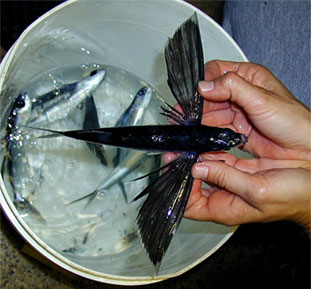
Reproduction
Pompano dolphins begin to spawn at a size of approximately 20 cm standard length. They are pair spawners, opposed to communal or mass spawners. The spawning season for dolphins is long, and multiple spawnings per year are common in both males and females. In the tropics, they spawn year round. Young dolphins have been found year round in the Straits of Florida, supporting this assumption. In the northern and southern extremes of the range, they apparently spawn only in the warmer months. In laboratory conditions, dolphins have spawned both during the day and night. Larvae are found in tropical waters worldwide. Young dolphins are found in the Florida Current year round, but peak abundance occurs in the summer. Larvae hatch at approximately 4 mm in length; within four days, they reach a length of 5.7 mm. At 15 days, the larvae are approximately 15 mm long. Vague adult characteristics are visible at this size, and the eyes and mouth are fully developed. Juvenile pompano dolphins tend to be solidly colored at very small sizes, developing light barring between lengths of 25-90 mm.
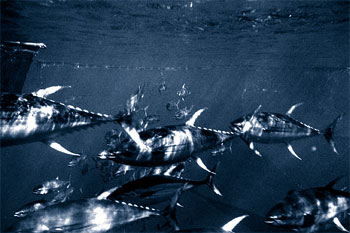
Predators
Large piscivorouse fishes feed on the pompano dolphin including tuna, marlin, and sharks. Seabirds are also known predators of this fish.
Taxonomy
Linnaeus first described the pompano dolphin as Coryphaena equiselis in 1758. The name equiselis is believed to be a misprint on the part of Linnaeus from equisetis, the name used by Osbeck in 1757, upon whose work Linnaeus made his description. While there has been debate over which name to use, Coryphaena equiselis is now considered by most taxonomists to be valid. The genus name Coryphaena is from the Greek word “koryphaina” which means dolphin fish. Other names that have been used to refer to this fish include Coryphaena aurata Rafinsque 1810, Coryphaena azorica Valenciennes 1833, Coryphaena lessonii Valenciennes 1833, Lampugus neapolitanus Valenciennes 1833, and Lampugus punctatulatus Valenciennes 1833.
Prepared by: Susie Gardieff